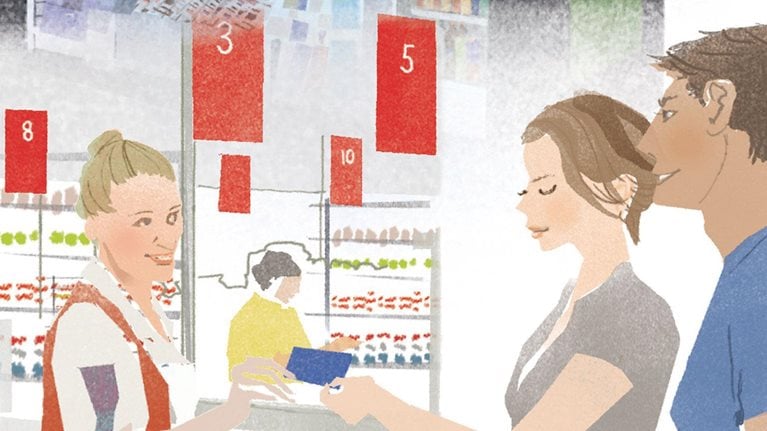Indonesia is a vast, sprawling country, with 250 million people spread out across more than 6,000 inhabited islands. Making products available to such a large and dispersed population requires partnering with the country’s myriad retailers, which operate a combined 4.1 million stores. Indonesian retail is dominated by small independent store owners, collectively known as “fragmented trade,” but modern retail—particularly convenience-store chains, supermarkets, and hypermarkets—is growing twice as fast as fragmented trade.
In short, Indonesia presents complex and evolving challenges for consumer-packaged-goods (CPG) companies. Our new report, Winning in Indonesia’s consumer-goods market, developed in collaboration with Nielsen, sheds light on how the country’s most successful CPG players are navigating the market. Drawing on our survey of 16 local and multinational CPG companies in Indonesia, as well as using Nielsen’s retail measurement of in-market performance, we examine what “winners” do differently from their peers—winners being companies that achieve higher sales growth than the categories they play in, while also outperforming peers on one or more customer- or channel-management metrics. We identified best practices in four areas.
1. Sales strategy
Winners in sales strategy serve both modern and traditional retailers well. In particular, they do the following:
-
Tailor assortment and promotions. More than half of winners, versus less than one-third of others, develop tailored products or packaging for their modern-trade customers. Half of winners also create custom promotions for key accounts.
-
In fragmented trade, prioritize resources. Even though modern trade is where most of the growth opportunities lie, winners view fragmented trade as a continued source of growth and set clear growth targets for their business in that channel. While all survey respondents segment their fragmented-trade accounts by sales volume, winners take it a step further: they prioritize resources—for example, by allocating a greater proportion of their trade investments to high-volume accounts.
2. Route to market (RTM)
Given the geographic challenges and the immense number of retail outlets in Indonesia, RTM planning and execution are extremely important for CPG companies. Best practices in RTM performance include the following:
-
Tailor the RTM model to the channel. At winning companies, only 45 percent of modern-trade accounts are served via distributors or third-party providers; the rest are served through direct sales (among nonwinners, the split is 80/20 in favor of distributors). Their coverage model allows winners to exert fuller control over their relationships with key accounts. Furthermore, winners treat their customers differently depending on cost to serve.
-
Manage distributor performance rigorously. Winners manage their distributors more closely and conduct performance reviews more frequently. They use several criteria to evaluate distributor performance, including financial returns and outlet coverage. Unlike most of their peers, winning companies differentiate pricing guidelines and discount policies for their distributors based on performance.
3. Pricing
Winners are able to raise unit prices above the category average while also increasing sales—dispelling the myth that low pricing is necessary to win in Indonesia. Instead, the following practices appear to be what set winners apart from others:
-
Use analytics to set and execute pricing strategy. Winners are more likely than others to adopt more-advanced analytical techniques (such as conjoint analysis) to inform their strategy for setting everyday shelf prices. In addition, they are more likely to use advanced pricing metrics such as net profit per unit and sales velocity (Exhibit 1).
-
Review and change prices more frequently. Most winners conduct pricing reviews at least quarterly for their largest and most profitable brands, whereas others do so only once or twice a year. Most winners change prices semiannually or more often; others tend to make price changes at most once a year. Most winners (versus less than half of others) are able to enforce their desired price in the market at least 80 percent of the time.

4. Trade and promotion
Companies that do best in this performance area are those that take a data-driven approach to trade investments and promotion planning. Winning companies emphasize the following elements:
-
Use more granular data to differentiate trade rates. Winners use more activity-based factors to differentiate trade rates by customer. They also gather data from a broader range of sources: all winners (and less than half of others) get data directly from their partner retailers, while half of winners (and no others) collect data using mobile and IT tools.
-
Analyze the impact of promotions at least monthly. Most winners conduct event-level postpromotion analysis at least once a month. Interestingly, winners favor certain metrics in evaluating promotion effectiveness (Exhibit 2). For example, they all measure incremental return on investment. Two-thirds of winners use a metric that others completely ignore: impact of a trade promotion on the overall category.

Moving from good to great
Learning from best-practice Indonesian companies is instructive in itself. That said, our global survey on customer and channel management1 allows us to compare the practices of Indonesian CPG companies with those of their counterparts around the world. We identified five success factors for Indonesian companies to consider if they seek to become world class.
Clear guidelines for field sales teams. Companies can give sales teams specific directives and detailed guidance regarding, for example, promotions to execute or SKUs that should be in stock—not just for each account but for each store format or, even better, for each outlet. Currently, no Indonesian companies give guidelines at the outlet level.
Greater use of advanced analytics and technologies. Advanced analytics can help improve in-store execution, trade-performance optimization, and innovation. Other technologies, too, can have dramatic impact. Mobile devices, for instance, have strengthened the capabilities of field teams, particularly in data capture and route planning.
A single ‘center of excellence’ to oversee both pricing and trade. At many Indonesian companies, pricing employees are organizationally separate from trade employees and are distributed across various customer teams or brand teams. We’ve found, however, that companies with a single center of excellence at either the business-unit level or corporate level tend to achieve higher sales growth than their competitors.
A dedicated e-commerce team. The rise in Internet penetration and usage is a real and continuing trend. Indonesian companies would do well to start investing in online and mobile initiatives. They may soon need to consider dedicating resources to e-commerce, especially in the areas of key-account management, marketing, and sales planning.
Containment strategies for channel conflicts. Because they serve both modern and traditional retailers, CPG companies will inevitably experience channel conflicts, which will only grow once e-commerce becomes a viable channel in the Indonesian market. Companies can quantify these conflicts, then design and implement containment strategies such as coordinated promotional calendars or differentiated packaging for different channels.
Indonesian CPG manufacturers have much to learn from one another, as well as from their counterparts and competitors in Asia and across the globe. By emulating best practices in customer and channel management, Indonesia’s CPG players can position themselves to win in an increasingly competitive and fast-changing market.
Download the full report from which this article is extracted, Winning in Indonesia’s consumer-goods market (PDF–3MB).


